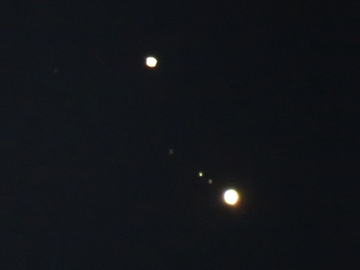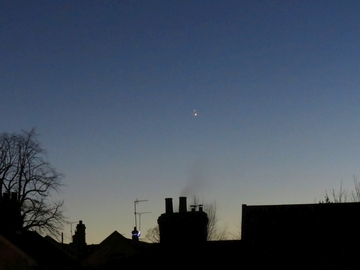 |  |
| Here we have the situation in the deep dusk on 19th Dec. The separation was already very small - just a quarter of a degree in fact (half the diameter of the Moon). | And a somewhat zoomed-in view later on the same evening. Saturn is rather less bright, above Jupiter. |
 | This is what I mean by a "nearly telescopic view". By using maximum zoom it was possible to reveal the moons of Jupiter. Here we see (in increasing distance from the planet) Europa, Ganymede & Callisto: Io was behind Jupiter so not visible. The star just visible well to the left of Saturn has the catchy name of HIP99314! |
 |  |
| By the 20th the separation was down to 9 arc-minutes (where there are 60 arc-minutes in a degree) - less than one-third of the diameter of the Moon. | While not the closest planetary conjunction I have ever captured, it is exceptionally close for Jupiter & Saturn. |
 | The "telescopic" view again shows Jupiter's moons, but actually only three of them once more - the least bright "moon" (furthest from the planet) is in fact the star HIP99314 again, showing how far both planets have moved in just one day. The true moons are Ganymede then Callisto to upper left and Europa to bottom right: Io would have been visible between Europa and Jupiter but was masked by the over-exposed disc of the planet. If you look carefully to the right of Saturn (and directly above Jupiter) you can just see its largest moon, Titan. Click on the image to see an enhanced version which shows it more clearly - hopefully without the need to enlarge the image! |
 |  |
| To end, here's a more "pictorial" shot taken a little earlier on the 20th when the sky was brighter. And if you are wondering about "standard size" comparisons, which I have shown for other conjunctions on the main page, just click on the scaled and cropped image to the right. The Moon-disc is not representative of the situation at the time (it was actually at First Quarter) but it is the same size as the grey disc used before so gives an accurate comparison. And unfortunately that was it. Skies were cloudy the next day so I missed the closest approach, when the separation was a mere 6.1 arc-minutes. Overcast conditions then persisted for several days afterwards so by the time we did get some clear evenings the planetary pair had disappeared into the twilight. Ah well - there's another equally close conjunction in 2080 (but it's in the morning so set your alarm now!) | |